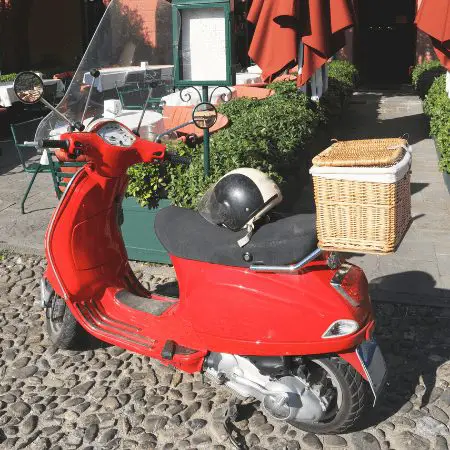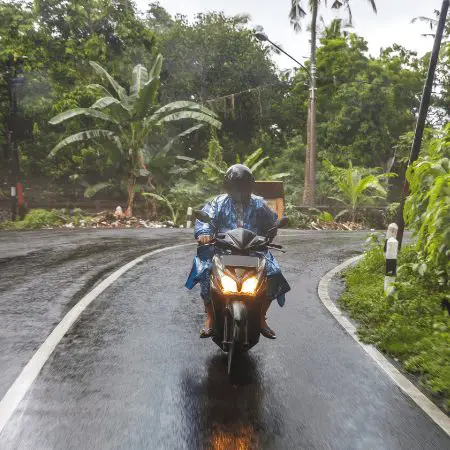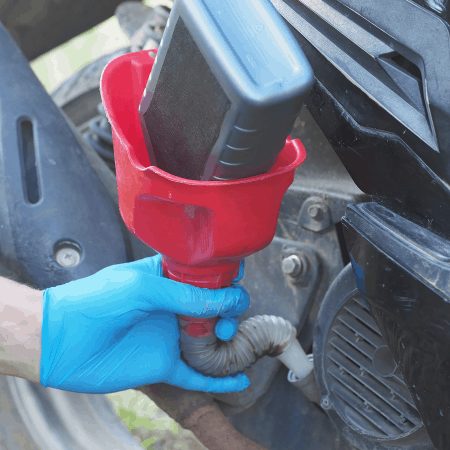I feel like scooterists that go with the 50cc scooter (aka moped) option are trying to solve a transportation need and live within a city’s limits. Quick jaunts around a small grid are where these scooters shine.
You may not need a license adjustment, and they are affordable. What happens when you need or want to get out of the bubble of your normal day? Want to go for a joy-ride out on a backcountry road or around a beautiful lake? The crisp wind on a beautiful day with some great scenery is the epitome of a nice ride.
If you are wanting to get out of what is likely a typical city commute to enjoy some scenery on your scooter, you’re bound to wonder how far you can actually go on it.
50cc scooters are limited on their speed, but they can travel as far as you are physically able to ride with proper route planning, in addition to, rest stops at least every 1 hour.
Are 50cc Scooters Capable of Long Distances?
What is long to you? Are you just used to a 5-mile radius, so you’re curious if you can go 20 miles? Do you want to go joy-riding for hundreds of miles?
Regardless, both mileage ranges are within your reach, but both require a bit of planning to make it a good experience.
Plenty of stories abound on what a great trip a scooterist has h for several hundred miles. Long trips can be done! There are also plenty of stories of the breakdowns that have happened when trying to go long distances on a 50cc scooter. Machines do breakdown, so you can’t insulate yourself from every bad situation that could occur while out on a ride.
That applies to even your short jaunts, so that is nothing new to what your scooter can do. However, there are steps to take before and during your trip that can help your trip be a success and go as far as you hope to.

Overarching Engine Conversation
Whether you have a 2-stroke or 4-stroke, it doesn’t matter. It is just a good idea to understand the nuance of your scooter on a longer journey than you normally ride whether this is a 30 mile trip to grandmas or a touring excursion.
Running your scooter at its max speed for a long period of time is a recipe for disaster. They aren’t designed to go at the max for long, so don’t overwork your scooter. You can hear the difference in the motor.
If you don’t know what the sound of your scooter sounds like at the top of its limit, get your gear on and find a safe place to play before you hit the open road for a trip. Play around with your speed to hear the max versus what it sounds like at 30-35mph.
Take breaks. Give your scooter’s engine a break and yourself a break to keep fresh. I’ll talk about this in greater detail in a moment, but the general idea is to keep your scooter happy within its limits.
There is a lot of hate out there for the scooters out of China that run less than $1000. I do not have personal experience with them. However, unless you are a seasoned mechanic, I would be cautious with taking these too far before they are broken in. They are notorious for running fine for close to a year, and then BAM! They don’t.
Prepping for a Long Ride
Mindset
You’ll need the right mindset to have a good long trip. Nope, no meditation-based advice here, but embarking on a long trip is all about endurance.
You are not trying to win a race but leisurely enjoy the journey.
The nature of a 50cc means you have to embrace the speed limitations as part of the ride, so at no point should you plan to dog your motor for an extended period of a long ride.
Your Scootering Experience
If the farthest you have ridden your scooter is within a 5-mile radius of your home, taking on a 150-mile trip today is probably not the best idea without a bit of training. Just some simple commutes have gotten you comfortable scootering around I’m sure, but you will want to gradually increase the distance you cover to tackle something bigger.
If you can go 20, add another 10 on your next long ride out. The wind can be quite tiring on the body.
Riding a scooter can be physically hard over time based on the way you sit for periods of time and using your body as a wind barrier. It’s not as easy as it sounds over a stretch.
You’re literally fighting holding yourself upright against it, so seriously – core exercises will help prepare you for long rides.
Gradually work towards increasing your mileage and comfort level just as if you were training for a marathon.
Consider the increases to be practice runs for a big event. If you discover that your shoulders get uncomfortable at 75 miles, this gives you time to experiment with alleviating this issue such as a windshield.
Whatever your issue, you’ll be able to handle it because that is a tough thing to address when you’re in the middle of nowhere with your aches and pains and a bottle of ibuprofen to make it home.
Plan Your Route
Moped riders attempting a long ride have to consider their route carefully. Just saying that you should just travel back roads isn’t enough in this case.
Your 50cc scooter likely maxes out in the 30 – 40 mph range. With that in mind, you need to consider the road speeds and plan a route that you can scoot around on safely.
The weight of you and the gear plus the terrain also comes into play.
Yes, it is legal in a lot of states to go up to 15mph under a speed limit, but one of the biggest issues with going slower than the surrounding traffic leads to distracted drivers just not seeing you in time to react.
Plan routes on roads that are 45mph or even lower preferably since this is a huge safety issue for scooters specifically.
Planning your route through traditional navigation apps on your smart home is tricky.
Waze has some components that seem a bit more helpful. In your Settings under Navigation, you can turn off toll roads, turn off freeways, opt to avoid difficult intersections, and you can set your vehicle type to Motorcycle (instead of the Private car default). This should show you some slower options with a more scenic route on the fly, but it is not fool-proof. I tested this out to get to places around me, and Waze did put me on a feeder to a highway that I generally try to avoid. The speed limits are in the 45mph range, but generally, drivers treat feeders as if they are actually a part of the interstate highway around here.
There are truck commercial routing apps like CoPilot Pro that let you put in a max speed if you randomly have access to this kind of app through your day-to-day job or if you are willing to pay for the convenience. This app includes some offline capabilities which can be very handy on those back-road drives, too.
ScootRoute and CaliMoto are options to check out, as well.
If you are in the bucket of riders that wants to tackle a trip that is several hundred miles long, make sure your backroad routes incorporate interesting places. The interest will truly make the ride that much more enjoyable!
Check the Weather
You’ll be going fairly slow, and if you’re looking to travel 100 miles, you could encounter weather hiccups. I know in my area, we had creeks out of their banks and blocking nearby roadways, but my sister is high and dry 50 miles away. They had rain, but they missed out on our torrential downpours from the last 2 days. Just be weather aware.
Check the weather before you go, and you could also check when you’re taking rest stops to be on the safe side.
A couple of thoughts to consider on weather:
- A 2 stroke will be more temperamental in cold weather.
- If it’s above 93°F, don’t forget to pack some water.
- Guide to riding in the heat
- Guide to riding in the cold
Regardless of the weather you’re riding in, put some thought into making sure you are dressed to ride safely and comfortably for the season.

Take Everything You’ll Possibly Need
Possible weather issues? Rain gear and layers. Possible maintenance issues? Tools. Want to steer clear of dehydration issues? Water.
I am all about using things I have that can serve multiple purposes. The list below incorporates things that can be used for other outdoor hobbies such as cycling or running. Items designed for those sports are designed to be lightweight and compact, so they work well for scooter needs. I included links to Amazon where it makes sense in case you need more detail or to purchase anything.
Full Recommendation List That Grows as Your Distance Does
I personally carry items 1-10 in my scooter at all times when commuting even.
- Cell phone for your route and emergencies
- Duct Tape because I’m always amazed at what this marvel can do in a pinch
- Zip ties are my favorite thing in the garage. Seriously.
- Flashlight. I use this rechargeable one. Just remember to recharge!
- Screwdriver at least. I use a multi-tool normally used for a bicycle because it’s lightweight and practical.
- Patch kit and mini pump for your tires
- Small first aid kit
- Rain Gear. I know it’s tempting to buy large, but buy enough to go over your safety gear only. You don’t want excess flapping in the wind.
- At least 1 layer of your choice to throw on under your jacket in case it gets cooler than you expect
- Water. If you’re going quite far, you’ll want to think through a hydration plan. Husband’s water pack. Mine. We also use these for other activities, and we’ve both been pleased. His is a better value. Mine is lighter. Check this article out for heat specific details
- Gas if you’re pushing your limits to your miles per gallon back roads. There may be long stretches without a fuel station.
- Bring oil if you’re on a 2 stroke scooter
- Are you staying overnight somewhere? Then that gear would be needed.
This list grows the further out you go, clearly! Once you start layering in all of this gear, you then need to consider how to carry it all. That’s why I tend to stick with items that are compact and lightweight where possible. Packing a scooter requires some creativity and patience!
Pre-Ride Inspection
Before you head out, make sure the maintenance on the scooter is up to date. Oil changes, lubrication, belts, etc. In addition, before heading out, I’d specifically check out the following:
- Tire pressure and tire wear
- Engine’s oil level
- Test out signals and such
- Make sure everything is tight without leaks

During Your Ride Considerations
How Far Will a Tank of Gas Take You on a Moped?
50cc scooters use less gas because their power output is lower, but having a good idea on the range is handy for route planning, too.
To understand how far your tank will get you, you’ll want to know how much gas it holds and the miles per gallon. I find that the published mpg is lower than the mpg in reality.
The average 50cc scooter has a 1.3 gallon tank whereas Vespa scooters have a 2.1 gallon tank.
In general, 2-stroke 50cc scooter will go as far as 135 miles per tank if ridden optimally. A 4-stroke scooter averages 151 miles per tank.
Optimal riding is how the miles per gallon ratings are created, so no heavy throttling coming off of stops and cruising along without the motor being constantly pushed to its max, too.
You will not want to literally push your scooter at any point in the trip from running out of gas, so in your route planning, consider your gas needs. A good rule of thumb is to never let your tank get less than 1/3 full.
Rest Stops
Not only do you need rest stops, but your scooter will need them, as well. There is a chance that going 30mph has started to creep up to the 40mph range, and you’re pushing the RPMs of your scooter. Translation: you might be pushing your scooter’s motor too hard, so giving it a break is a good idea.
If you are traveling 70 miles (the absolute max I’d push it for gas on a 4-stroke) at an average of 30 miles per hour, you’ll be on the road 2 hours and 20 minutes of solid riding time. That is a lot of riding time all at one time, so think through your realistic expectations with that whole mindset thing where you aren’t looking to win a race. Consider how many miles this trip will take you, and then back into how much you think you can reasonably stay on the scooter all at one time.
I’d recommend breaking every half hour to hour of a trip for sanity, enjoyment and to ensure my scooter was happy. Remember, you planned your route for interest. Go see it all!
At the rest stop, a bio-break is assumed, but also drink before you’re thirsty. Food is also an option, but you may not want to eat every half hour.
If you’re going over 200 miles, I’d recommend going through at least a piece of the pre-ride inspection by checking the tire pressure and the engine oil level.
Safety Chat
Don’t forget to wear your safety gear!
We have covered the importance of the rest stops for your scooter, but did you know that the risk of an accident increases the longer you ride? It’s not the long ride, but it is the likelihood of you getting more and more fatigued as the day goes on.
Scootering is a lot more tiring than you’d think with wind resistance and staying in the same position for hours on end. Even with the rest stops, you will have to make a conscious effort to stay focused and alert if you quite literally are planning on hours.
Hydrate with water and add in electrolytes if it’s beyond about 95° F or more. Eat light to avoid getting sleepier and to help your body focus on keeping your temperature regulated rather than digesting a heavy meal.
Ride like no one actually sees you, and don’t forget to wear reflective and/or bright gear.
